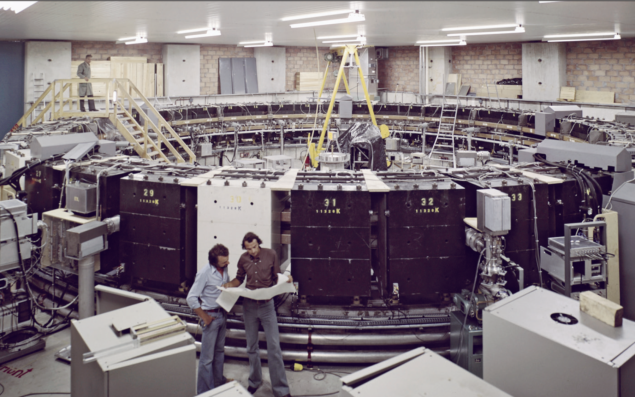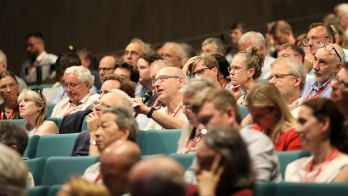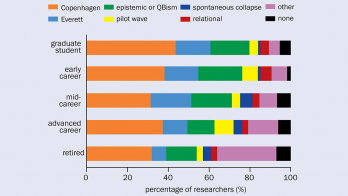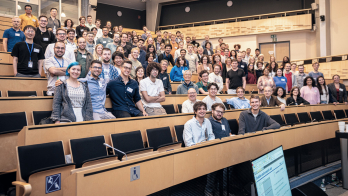The long-awaited g–2 result from Fermilab offers a moment to reflect on the perseverance and tight collaboration required by theorists and experimentalists to deliver progress, write Themis Bowcock and Mark Lancaster.

It has been almost a century since Dirac formulated his famous equation, and 75 years since the first QED calculations by Schwinger, Tomonaga and Feynman were used to explain the small deviations in hydrogen’s hyperfine structure. These calculations also predicted that deviations from Dirac’s prediction a = (g–2)/2, where g is the gyromagnetic ratio e/2me, should be non-zero and thus “anomalous”. The result is famously engraved on Schwinger’s tombstone, standing as a monument to the importance of this result and a marker of things to come.
In January 1957 Garwin and collaborators at Columbia published the first measurements of g for the recently discovered muon, accurate to 5%, followed two months later by Cassels and collaborators at Liverpool with uncertainties of less than 1%. Leon Lederman is credited with initiating the CERN campaign of g–2 experiments from 1959 to 1979, starting with a borrowed 83 × 52 × 10 cm magnet from Liverpool and ending with a dedicated storage ring and a precision of better than 10 ppm.
Why was CERN so interested in the muon? In a 1981 review, Combley, Farley and Picasso commented that the CERN results for aμ had a higher sensitivity to new physics by “a modification to the photon propagator or new couplings” by a factor (mμ/me)2. Revealing a deeper interest, they also admitted “… this activity has brought us no nearer to the understanding of the muon mass [200 times that of the electron].”
With the end of the CERN muon programme, focus turned to Brookhaven and the E821 experiment, which took up the challenge of measuring aμ 20 times more precisely, providing sensitivity to virtual particles with masses beyond the reach of the colliders at the time. In 2004 the E821 collaboration delivered on its promise, reporting results accurate to about 0.6 ppm. At the time this showed a 2–3σ discrepancy with respect to the Standard Model (SM) – tantalising, but far from conclusive.
Spectacular progress
The theoretical calculation of g–2 made spectacular progress in step with experiment. Almost eclipsed by the epic 2012 achievement of calculating the QED contributions to five loops from 12,672 Feynman diagrams, huge advances in calculating the hadronic vacuum polarisation contributions to aμ have been made. A reappraisal of the E821 data using this information suggested at least a 3.5σ discrepancy with the SM. It was this that provided the impetus to Lee Roberts and colleagues to build the improved muon g–2 experiments at Fermilab, the first results from which are described in this issue, and at J-PARC. Full results from the Fermilab experiment alone should reduce the aμ uncertainties by at least another factor of three – down to a level that really challenges what we know about the SM.
Muon g–2 is a clear demonstration that theory and experiment must progress hand in hand
Of course, the interpretation of the new results relies on the choice of theory baseline. For example, one could choose, as the Fermilab experiment has, to use the consensus “International Theory Initiative” expectation for aμ. One could also take into account the new results provided by LHCb’s recent RK measurement, which hint that muons might behave differently than electrons. There will inevitably be speculation over the coming months about the right approach. Whatever one’s choice, muon g–2 is a clear demonstration that theory and experiment must progress hand in hand.
Perhaps the most important lesson is the continued cross-fertilisation and impetus to the physics delivered both at CERN and at Fermilab by recent results. The g–2 experiment, an international collaboration between dozens of labs and universities in seven countries, has benefited from students who cut their teeth on LHC experiments. Likewise, students who have worked at the precision frontier at Fermilab are now armed with the expertise of making blinded ppm measurements and are keen to see how they can make new measurements at CERN, for example at the proposed MUonE experiment, or at other muon experiments due to come online this decade.
“It remains to be seen whether or not future refinement of the [SM] will call for the discerning scrutiny of further measurements of even greater precision,” concluded Combley, Farley and Picasso in their 1981 review – a wise comment that is now being addressed.








